|
Yanmar SB12:
Engine Removal
This page was last updated on 2 August 2001.
It was only just over a year ago, in late May
and early June 2000, that I worked diligently to install the Yanmar SB 12 that
proved to be such a disappointment. (Forget how I did that? Click here
to go back in time.) It seemed strange to be about to undertake the
removal of the engine, and to replace it with a brand new one.
The last thing I really wanted to do was haul
my boat during the prime of the season, but the handwriting was on the wall--it
was time to do the repower. With the new engine sitting in my garage, I
just had to make a call to schedule the boatyard for what I hoped would be a
quick haulout. Although I wasn't sure, I figured I should be able to do
the repower over a five day period.
|
|
MONDAY 7/31/01
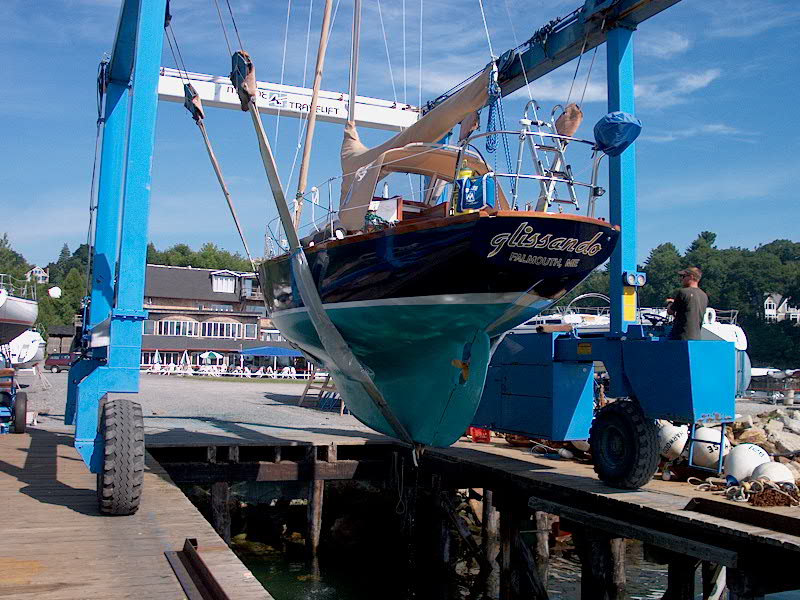 I
motored Glissando from her mooring into the nearby boatyard for the scheduled
haulout--the last time I would be running the old engine. True to form,
the SB 12 smoked up a storm. The day had dawned foggy on the coast, and I
joked with the Travellift operator that my engine was actually the cause of the
fog. Within minutes, my pride and joy was plucked unceremoniously from the
water and deposited on the hard--right next to a lovely, ripe-smelling
dumpster. Thanks, guys--I guess they didn't want me to hang around the
yard too long! I
motored Glissando from her mooring into the nearby boatyard for the scheduled
haulout--the last time I would be running the old engine. True to form,
the SB 12 smoked up a storm. The day had dawned foggy on the coast, and I
joked with the Travellift operator that my engine was actually the cause of the
fog. Within minutes, my pride and joy was plucked unceremoniously from the
water and deposited on the hard--right next to a lovely, ripe-smelling
dumpster. Thanks, guys--I guess they didn't want me to hang around the
yard too long!
The first order of business, once the boat was
blocked, was to eliminate my one and only item on my "rely on others"
list. Buttonholing the service manager, we went to find the yard's prop
puller--a piece of equipment that, tragically, I do not own. The new
engine requires a new propeller with different pitch. I had to remove the
prop before doing anything else because it has to be done before breaking loose
the coupling inside--the puller requires that the shaft be stationary. A
few minutes later the prop clanged off; I returned the puller, and then began my
week of self-sufficiency.
|
|
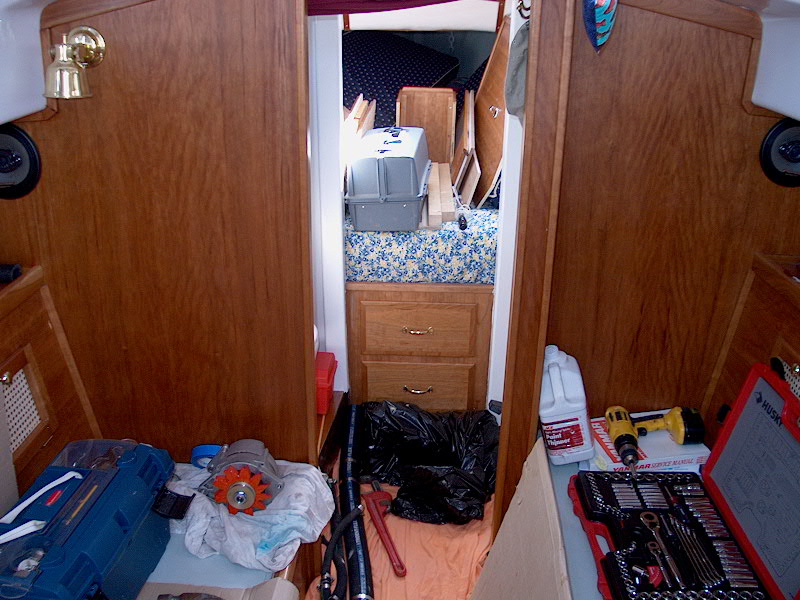 First,
I spent some time preparing the boat for the traumatic event ahead. Using
a large piece of corrugated cardboard, I created a sort of custom protective pad
inside the cabin, covering the sole and even turning the cardboard up the sides
of the settees and covering the port berth as well. Then, I spread a
number of drop cloths everywhere, inside and out. I moved the settee
cushions and most of the stuff from the cockpit lockers up to the vee berth, and
spread out my tools in the cabin for easy access. Now I was ready to
really get into it! First,
I spent some time preparing the boat for the traumatic event ahead. Using
a large piece of corrugated cardboard, I created a sort of custom protective pad
inside the cabin, covering the sole and even turning the cardboard up the sides
of the settees and covering the port berth as well. Then, I spread a
number of drop cloths everywhere, inside and out. I moved the settee
cushions and most of the stuff from the cockpit lockers up to the vee berth, and
spread out my tools in the cabin for easy access. Now I was ready to
really get into it!
I began by disconnecting the batteries, and
then the alternator and starter connections on the old engine. I labeled
these wires for future reference and taped them to the side of the engine room
to keep them out of the way. Next, I disconnected the raw water intake
hose, the exhaust hose--it was lined with nasty black carbon from the obviously
excellent and efficient operation of the engine--and the fuel line. I
removed the old control cables and the engine shut-down cable, and then
disconnected the shaft coupling from the Drivesaver on the engine. Then, I
removed the bolts securing the engine to the mounts, and, to make removal
easier, cranked up the bottom adjusting nuts to raise the engine mount flanges
to nearly the top of the studs. This is helpful since the engine is set
back from the companionway, and the chain hoist must sort of pull the engine
forward first, as well as up--pulling it over the exposed studs can be
difficult. The after two mounts were hard to reach with the big wrench, so
eventually I gave up trying to raise those too much. I also removed the
raw water strainer from beneath the engine to give the thing a little more
clearance coming out.
|
|
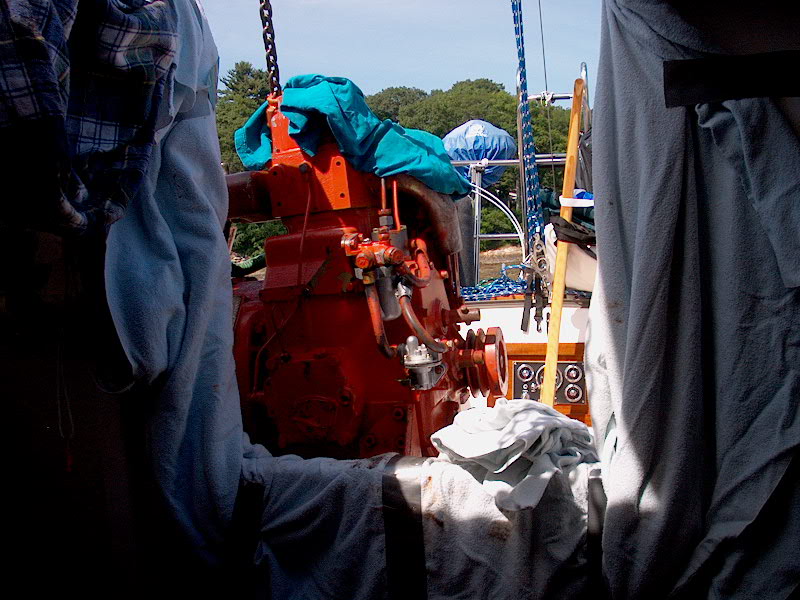 Next,
I rigged up my trusty chain hoist from the boom above the companionway. I
moved the main halyard to the center of the boom, and protected the sailcover
with a rag wrapped round. I hung the chain hoist from a thick line that I
tied around the boom, and hooked it to the engine. Now I slowly started
taking tension, to see how the engine would move. Soon, I noticed that the
boom was being pulled down, and the engine was not really moving--it was stuck
on those after engine mount studs. I ended up removing the lags that hold
the mounts to the engine foundation, which was possible with a little contorting
and creative wrench use--the clearance is tight around the engine flanges.
Soon, though, the lags were out, and I hoisted the Next,
I rigged up my trusty chain hoist from the boom above the companionway. I
moved the main halyard to the center of the boom, and protected the sailcover
with a rag wrapped round. I hung the chain hoist from a thick line that I
tied around the boom, and hooked it to the engine. Now I slowly started
taking tension, to see how the engine would move. Soon, I noticed that the
boom was being pulled down, and the engine was not really moving--it was stuck
on those after engine mount studs. I ended up removing the lags that hold
the mounts to the engine foundation, which was possible with a little contorting
and creative wrench use--the clearance is tight around the engine flanges.
Soon, though, the lags were out, and I hoisted the  engine
up, up and away, setting it--with some effort--onto the bridgedeck in the
cockpit, which was protected with rags and a piece of plywood. Then,
moving the chain hoist slightly aft on the boom, I moved the engine to the
safety of the cockpit well. engine
up, up and away, setting it--with some effort--onto the bridgedeck in the
cockpit, which was protected with rags and a piece of plywood. Then,
moving the chain hoist slightly aft on the boom, I moved the engine to the
safety of the cockpit well.
I had originally thought I'd hire the yard's
crane to lift the old engine down from, and the new engine up to the
cockpit. Soon, though, I started thinking that there was no reason I
couldn't use the boom to swing the engine out over the side of the boat, and
lower it into my waiting truck below. By the end of the afternoon, I had
decided to proceed in this manner, and I soon had the engine hooked to the hoist
again, the boom swung out, and I lowered the engine onto the crude wooden
platform that I had saved from when the engine was shipped to me. Nothing
to it!
|
|
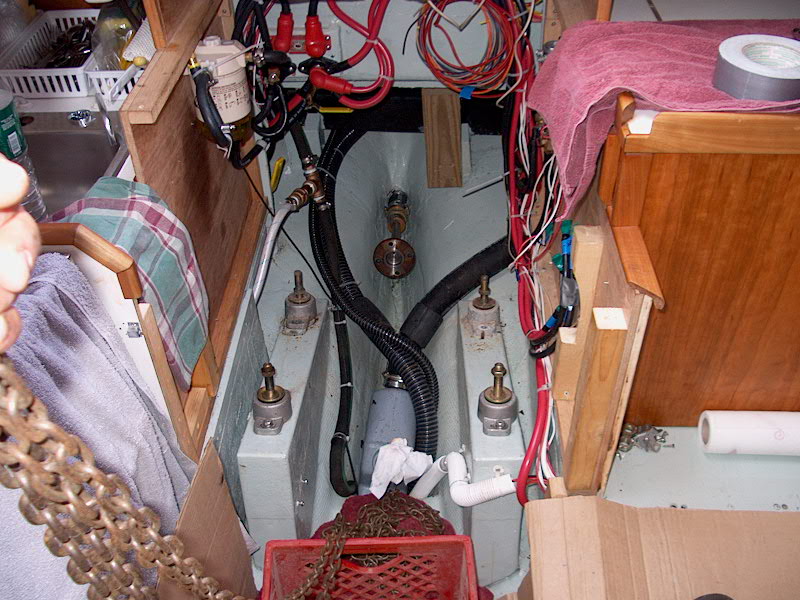 This
left behind a relatively empty engine bay. I spent some time cleaning things
up--it wasn't too dirty, but I degreased everything and cleaned up beneath the Waterlock
in the bilge. I removed the wiring harness from the old instrument panel,
which I am replacing, and cleaned out anything else that was unnecessary.
I removed the old engine mounts, and then pulled the shaft and coupling out from
the inside--I am reusing the coupling, so there was no need to remove it But
first, I temporarily placed my new engine template on the beds and, using the
shaft coupling, marked where the mounts would go. I moved the marks
forward an inch to account for the Drivesaver coupling. These marks will
be critical for the placement of the new engine, as it must be able to mate with
the existing shaft. I also removed the stuffing box so that I'd have a
clear view of the stern tube for running my alignment string.. This
left behind a relatively empty engine bay. I spent some time cleaning things
up--it wasn't too dirty, but I degreased everything and cleaned up beneath the Waterlock
in the bilge. I removed the wiring harness from the old instrument panel,
which I am replacing, and cleaned out anything else that was unnecessary.
I removed the old engine mounts, and then pulled the shaft and coupling out from
the inside--I am reusing the coupling, so there was no need to remove it But
first, I temporarily placed my new engine template on the beds and, using the
shaft coupling, marked where the mounts would go. I moved the marks
forward an inch to account for the Drivesaver coupling. These marks will
be critical for the placement of the new engine, as it must be able to mate with
the existing shaft. I also removed the stuffing box so that I'd have a
clear view of the stern tube for running my alignment string..
By my calculations, the only modification to
the engine beds that will be necessary will be to add slightly to their
height. That's where the slick engine alignment template comes into
play. But it was the end of the day, and modifying the beds will be
tomorrow's project.
|
|
Click here
to continue.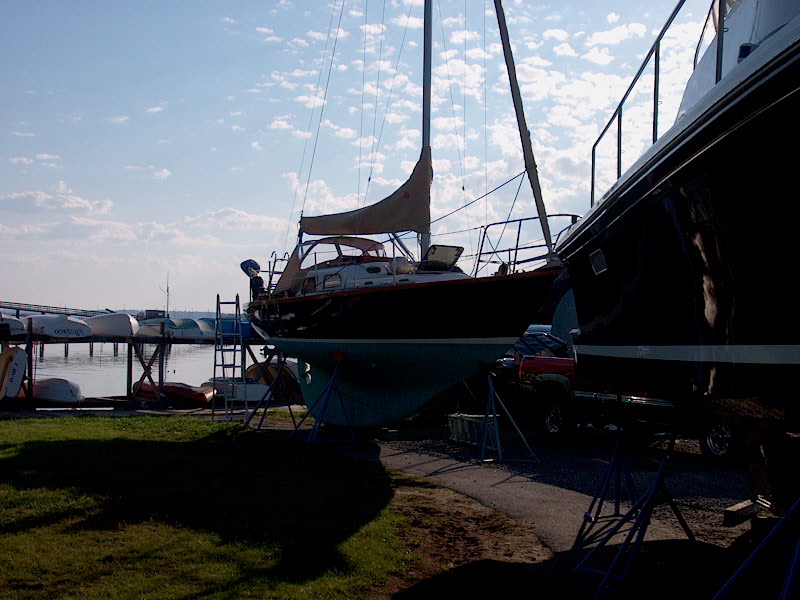
|
|